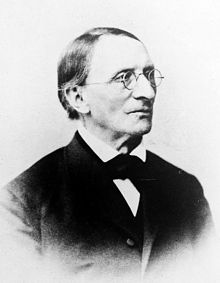카를 루트비히
Carl Ludwig카를 루트비히 | |
|---|---|
 | |
| 태어난 | 1816년 12월 29일 |
| 죽은 | 1895년 4월 23일 ()(78세) |
| 수상 | 코플리 메달 (1884) |
| 과학 경력 | |
| 필드 | 생리학 |
칼 프리드리히 빌헬름 루트비히(독일어: [ [lulutvtv]; 1816년 12월 29일 – 1895년 4월 23일)는 독일의 내과 의사 및 생리학자였다. 연구자 겸 교사로서의 그의 업적은 생리학의 거의 모든 분야에서 사용되는 이해, 방법, 기구에 큰 영향을 미쳤다.
1842년 루트비히는 생리학 교수가 되었고 1846년 비교 해부학 교수가 되었다. 취리히와 비엔나의 교수직에서 그는 1865년에 라이프치히 대학교로 가서 그 곳에서 생리학 연구소를 개발했는데, 그 곳에서 그의 이름을 따서 오늘 지정되었다: 칼 루트비히 생리학 연구소였다.[1] 루트비히는 혈압의 생리학, 소변 배설, 마취와 같은 몇 가지 주제를 연구했다. 그는 연구로 1884년에 코플리 훈장을 받았다. 1869년 스웨덴 왕립 과학 아카데미의 외국인 회원으로 선출되었다. 그는 스트로뮤어를 발명한 것으로 유명하다.
1932년부터 독일 심장학회가 심혈관계 연구 분야의 우수 연구자들에게 수여하는 칼 루트비히 명예훈장은 독일 심장학회가 수여하는 상이다.
인생
루트비히는 카셀 근처의 비트젠하우젠에서 태어났으며, 1839년 마르부르크에서 박사학위를 받으며 에를랑겐과 마르부르크에서 의학을 공부했다. 그는 해부학과 생리를 연구하고 가르치면서 그 후 10년 동안 마르부르크를 그의 고향으로 만들었고, 처음에는 FL Fick(1841), 그 다음에는 민영화(1842), 그리고 마지막으로 특별 교수(1846년)로 활동했다. 1849년 취리히의 해부생리학 교수로 뽑혔고, 6년 후 군 외과의 요셉티눔 학교 교수로 빈에 갔다.[2]
In 1865 Ludwig was appointed to the newly created chair of physiology at Leipzig, and continued there until his death on 23 April 1895.[2]
Appraisal
Ludwig's name is prominent in the history of physiology, and he had a large share in bringing about the change in the method of that science that took place in the middle of the 19th century. With his friends Hermann Ludwig Ferdinand von Helmholtz, Ernst Wilhelm von Brücke, and Emil du Bois-Reymond, whom he met for the first time in Berlin in 1847, he rejected the assumption that the phenomena of living animals depend on special biological laws and vital forces different from those that operate in the domain of inorganic nature; and he sought to explain them by reference to the same laws as are applicable in the case of physical and chemical phenomena.[2]
This point of view was expressed in Ludwig's celebrated Text-book of Human Physiology (1852–1856), but it is as evident in his earliest paper (1842) on the process of urinary secretion as in all his subsequent work. Ludwig exercised enormous influence on the progress of physiology, not only by the discoveries he made, but also by the new methods and apparatus he introduced to its service. Thus in regard to secretion, he showed that secretory glands, such as the submaxillary, are more than mere filters, and that their secretory action is attended by chemical and thermal changes both in themselves and in the blood passing through them.[2]
Ludwig demonstrated the existence of a new class of secretory nerves that control this action, and by showing that if the nerves are appropriately stimulated the salivary glands continue to secrete, even though the animal be decapitated, he initiated the method of experimenting with excised organs. He devised the kymograph as a means of obtaining a written record of the variations in the pressure of the blood in the blood vessels; and this apparatus not only conducted him to many important conclusions respecting the mechanics of the circulation, but afforded the first instance of the use of the graphic method in physiological inquiries. For researches on blood gases, he designed the mercurial blood-pump that, with various modifications, has come into extensive use. He used it for many investigations into gases of the lymph, the gaseous interchanges in living muscle, the significance of oxidized material in the blood, etc.[2]
There is indeed scarcely any branch of physiology, except the physiology of the senses, to which Ludwig did not make important contributions. He was also a great power as a teacher and the founder of a school. Under him the Physiological Institute at Leipzig became an organized center of physiological research, whence issued a steady stream of original work; and though the papers containing the results usually bore the name of his pupils only, every investigation was inspired by him and carried out under his personal direction. Thus his pupils gained a practical acquaintance with his methods and ways of thought, and, coming from all parts of Europe, they returned to their own countries to spread and extend his doctrines. Possessed himself of extraordinary manipulative skill, he abhorred rough and clumsy work, and he insisted that experiments on animals should be planned and prepared with the utmost care, not only to avoid the infliction of pain (which was also guarded against by the use of an anesthetic), but to ensure that the deductions drawn from them should have their full scientific value. [2]
Notes
- ^ Current website of the Carl-Ludwig-Institute of Physiology http://cliphys.uniklinikum-leipzig.de/
- ^ a b c d e f Chisholm 1911, p. 114.
References
- Attribution
- This article incorporates text from a publication now in the public domain: Chisholm, Hugh, ed. (1911). "Ludwig, Karl Friedrich Wilhelm". Encyclopædia Britannica. 17 (11th ed.). Cambridge University Press. p. 114.
Further reading
- Luderitz B.: Carl Friedrich Wilhelm Ludwig (1816–1895). – Source Journal of Interventional Cardiac Electrophysiology 2004 Dec;11(3):221-2. PMID 15548890
- Zimmer HG.: The contributions of Carl Ludwig to cardiology. Can. J. Cardiol. 1999 Mar;15(3):323-9. PMID 10202196
- Davis JM, Thurau K, Haberle D.: Carl Ludwig: the discoverer of glomerular filtration. – Nephrol. Dial. Transplant. 1996 Apr;11(4):717-20. PMID 8671870
- Schubert E.: The theory of and experimentation into respiratory gas exchange—Carl Ludwig and his school. Pflügers Archiv (Pflügers Arch.) 1996;432(3 Suppl):R111-9. PMID 8994552
- Seller H.: Carl Ludwig and the localization of the medullary vasomotor center: old and new concepts of the generation of sympathetic tone. Pflügers Arch. 1996;432(3 Suppl):R94-8. PMID 8994549
- Thurau K, Davis JM, Haberle DA: 칼 프리드리히 빌헬름 루트비히: 현대 신생리의 창시자. Pflugers Arch. 1996;432(3 Suppl):R68-72. PMID 8994545
- 슈뢰어 H.: 루드비히의 미시순환의 생리학에 대한 과학적 개념의 관련성과 신뢰성. Pflugers Arch. 1996;432(3 Suppl):R23-32. PMID 8994539
- 짐머 HG: Carl Ludwig : 그 남자, 그의 시간, 그의 영향. Pflugers Arch. 1996;432(3 Suppl):R9-22. PMID 8994538
- 루트비히 CF: 1842—신피학계의 획기적인 사건: 칼 루트비히의 혁명적인 신장 기능 개념. 콩팥 인트(ernational) 1994년 10월 46:1–23. PMID 7823448
- 페 WB: 카를 루트비히 Clin. Cardol. 1991년 4월 14일 (4):361-3. PMID 2032415
- 페 WB: 칼 루트비히와 라이프치히 생리학 연구소: '새로운 지식의 공장' 발행부수. 1986년 11월 74일(5):920-8. PMID 3533314
외부 링크
| 위키미디어 커먼즈에는 칼 루드비히(생리학자)와 관련된 미디어가 있다. |
- 맥스 플랑크 과학사 연구소의 가상 연구실에서의 짧은 전기와 참고 문헌



